|
|
|
|
|
|
|
 | ||
| Mercury Unveiled Written by G. Jeffrey Taylor Hawai'i Institute of Geophysics and Planetology, University of Hawaii |
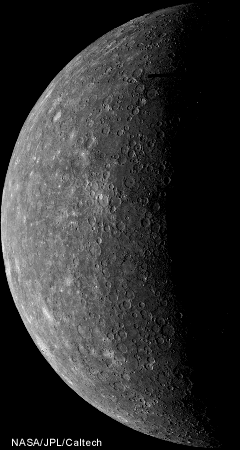 |
Mercury is an important part of the Solar System puzzle, yet we know less about it than any other planet, except Pluto. Mercury is the smallest of the inner, rocky planets (Mars, Earth, and Venus) and the closest to the Sun. Its relatively high density (5.4 grams per cubic centimeter) indicates that it has a large metallic core (about 3/4 of the planet's radius) compared to its rocky mantle and crust. The surface is heavily cratered like the highlands of the Moon, but some areas are smooth and less cratered, possibly like the lunar maria (but not as dark). Radar data suggest that Mercury, like the Moon (see PSRD article Ice on a Bone Dry Moon), has deposits of water ice in permanently shadowed areas at the poles. Unlike the Moon, where water is only at the south pole, Mercury has ice at both poles. (The water composing the ice deposits probably came from comets hitting the surface.) |
Planet Formation
In one view of how the Solar System formed, Mercury was assembled in the hottest region close to the Sun. This would have led to most of the iron being in the metallic state, rather than oxidized to FeO. If correct, the rocks on Mercury ought to have relatively low contents of oxidized FeO, less than about 3 wt.%. This hypothesis also predicts that Mercury should have higher concentrations of elements that have very high boiling points (called refractory elements), such as calcium and aluminum, and not much of the elements that boil at low temperatures (called volatile elements), such as sodium and potassium.
Another hypothesis tells a much more nomadic and dramatic story of Mercury's birth. This alternative view involves wandering planetesimals that might have come from as far away as Mars or the inner asteroid belt, and a monumental impact that stripped away much of the young planet's rocky mantle. Such a giant impact is considered by most planetary scientists as the most likely hypothesis for the origin of the Moon (see Lesson 1 from the Moon).
What does the impact hypothesis mean for Mercury? If correct, the composition of the rocky portion of Mercury might not be as depleted in FeO and volatile elements, or enriched in refractory elements, though such characteristics are not ruled out. The event could have stripped away much of the mantle, thereby increasing the amount of metallic core compared to rocky mantle.
 |
The smooth areas inside the larger craters in this photo of Mercury may be volcanic plains, somewhat like the maria on the Moon. There are many such smooth plains on Mercury. Some scientists have suggested that the plains were formed by rapidly-flowing material ejected from immense impact craters (called basins). However, the plains have smaller numbers of craters on them than do the ejecta blankets of impact basins, indicating a younger age. On some smooth plains, such as those inside the Caloris Basin, sinuous rilles occur, which are thought to be either lava channels or collapsed lava tubes, again suggesting a volcanic origin for the smooth plains. |
A key feature of lava flows on many planets is a composition different from the surface the lava sits on, as shown by the maria on the Moon being darker and higher in FeO. Are the smooth plains on Mercury volcanic? (See Lesson 3 from the Moon).
Testing the idea of volcanism requires knowing much more about the chemical composition of Mercury. That is why the work by Robinson and Lucey is so important. It gives us our first good glimpse of the nature of the surface and even the interior of Mercury. The first step in obtaining that glimpse was to calibrate the old data from the Mariner 10 mission.
Robinson and Lucey used data in two wavelengths to make false-color images of Mercury. On their images, the more red the color, the lower the abundance of dark, opaque minerals. Because ilmenite, FeTiO3, is a common opaque mineral, the more red the color, the lower the concentration of titanium (Ti).
They used green to indicate the combined effects of the FeO concentration and the amount of micrometeorite bombardment (also called "maturity"), so greener portions of the pictures are either lower in FeO or less mature. These two parameters cannot be separated as yet, but use of geological common sense allows us to guess which parameter is most important in a given area. For example, a young impact crater is surrounded by fresh debris excavated during the impact, which is very immature. No matter what the FeO concentration, the value of the iron-maturity parameter will be low, and the image will be distinctly green. However, like the Moon, most of the surface of Mercury is probably quite mature, so in areas between large craters the intensity of the green color is related to the concentration of FeO.
Finally, they used blue to indicate the intensity of the ratio of ultra-violet to visible light. Of course, these colors then combine in complicated ways, so the images are composed of more than red, green, and blue areas. In general, the different colors indicate variations in the elements, minerals, or other propeties of the materials present. Robinson and Lucey also used simple black and white images created for each compositional parameter. See How Mark Robinson and Paul Lucey Calibrated Images of Mercury from Mariner 10 for details.
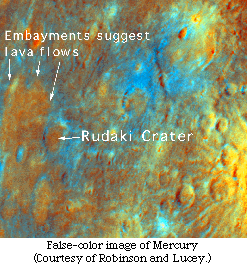 |
The new analysis of Mariner 10 data shows that at least some smooth plains are probably volcanic. A good example is west of the crater Rudaki (see image on the left and images below). Other scientists had pointed out that the boundaries of this unit form embayments (arrows), a feature typical of lava flows. However, they could not conclude that the material was lava because they had no way of determining that it was different in composition from the surroundings. The new analysis shows that the unit is distinct in color from its surroundings, which indicates a different composition, consistent with its origin as one or more lava flows. |
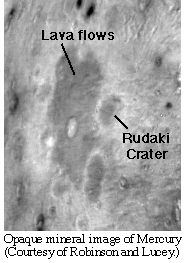 |
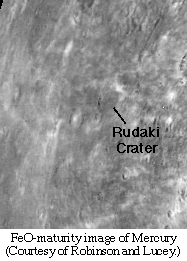 |
The iron-maturity index alone is not different from the surrounding surface. Assuming that the amount of micrometeorite bombardment is roughly uniform in this region, this suggests that the FeO concentration of the smooth plains lavas is about the same as most of the crust of Mercury. Comparison of Earth-based observations of an entire hemisphere of Mercury with the highlands of the Moon has led some scientists to suggest that on average the mercurian crust contains no more than 6 wt.% FeO. The lava flows near Rudaki, therefore, contain about 6 wt.% (or less) FeO.
Robinson and Lucey do not speculate in their paper on the significance of this observation, but they note in a paper submitted to the 28th Lunar and Planetary Science Conference that the iron content of the surface reflects that of the interior. (The abstract was co-authored by Paul Spudis of the Lunar and Planetary Institute, B. Ray Hawke of the Univ. of Hawai'i, and me.) If lava flows on Mercury formed the way they form on Earth, the FeO concentration in the lava is very similar to (but probably a bit higher than) that of the planet's interior.
So, the mantle of Mercury contains no more than 6 wt.% FeO. This is less than scientists estimate for the mantles of Earth and Venus (8 wt.%), the Moon (11-13 wt%), and much less than estimates (from the compositions of meteorites from Mars) of the martian mantle (18 wt.%). This is consistent with the idea that Mercury is a highly reduced object, but not as reduced as its proximity to the Sun would suggest (0 to 3 wt.%). The planetesimals that accreted to form Mercury probably came from a much wider region than near the present orbit of the planet. However, much more work needs to be done to test such speculations.
Explosive eruptions?
Volcanic eruptions can be explosive, producing high fountains of lava that break into tiny droplets. Many Hawaiian eruptions begin with such fire fountaining, or pyroclastic eruptions. The deposits are composed of rapidly-cooled droplets of lava ranging in size from 1/100 millimeter to about 1 cm.
| This 1959 pyroclastic eruption at Kilauea volcano in Hawaii sent lava up to 550 meters into the air. |
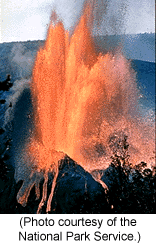 |
Excellent examples of pryoclastic deposits were seen on the Moon.
On Mercury, an area near the large crater Homer, 320 km in diameter, has a distinctive dark blue color on Robinson and Lucey's new color images. The white line outlines the degraded rim of this old crater.
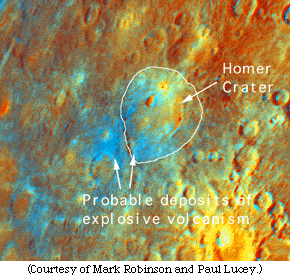 |
Most important, the blue area has fuzzy boundaries that seem to grade into the surroundings. This is what one would expect for a pyroclastic deposit. It is also similar to debris from an impact, but there is no crater in the center that would act as a source for the deposited material. In fact, the dark blue materials lie along a straight segment of a border of Homer, similar to some volcanic fissures on the Moon. |
If further analysis proves that these are pyroclastic deposits, it has dramatic implications for the amount of volatile elements inside Mercury. Fire fountains are driven by volatiles, usually gases such as CO, CO2, SO2, and H2O. If Mercury formed hot and contains only tiny quantities of such gases, where did they come from? Are they stored in isolated volatile-rich reservoirs? Or is Mercury not really so depleted in volatiles? No answers yet!
Big craters reveal compositional layering
 |
| The area near the craters Kuiper (60 km in diameter) and Muraski (125 km in diameter) gives some clues to compositional layering of the mercurian crust. Craters are quite useful in unraveling the nature of planets because they are natural drill holes. Kuiper crater is superimposed on the rim of the larger Muraski crater, so it is younger. The differences in the color image are mostly due to the difference in age of the two craters. The yellow-orange color of the rock dug up by these and other craters in this region of Mercury signifies that these deposits contain relatively few opaque minerals such as titanium. This indicates that the surface in this region of Mercury is underlain by a chemically distinctive layer at depth. |
![]()
|
|
[ About PSRD |
Archive |
Search |
Subscribe ] [ Glossary | General Resources | Comments | Top of page ] |